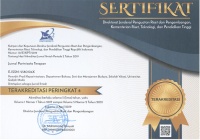Persepsi Wisatawan Domestik dan Mancanegara terhadap Pengelolaan Daya Tarik Wisata Jatiluwih, Kabupaten Tabanan, Provinsi Bali
Dewa Ayu Diyah Sri Widari(1*)
(1) Akademi Pariwisata Denpasar
(*) Corresponding Author
Abstract
Jatiluwih Tourism Attraction as part of the World Cultural Heritage is a tourist product consumed by tourists. Perception of tourists is important to be studied as a reference in the management of tourist attractions. Data collection techniques using survey methods are used to determine tourists' perception of Jatiluwih Tourism Attraction as part of the World Cultural Heritage. Questionnaires are used as research instruments to obtain information from tourists. After the data is collected, then the measurement is done using the Likert Scale. In determining the number of tourist samples used Slovin formula. Based on Slovin formula with a tolerance limit of 5%, the number of samples for foreign tourists as many as 204 people, and the number of samples for domestic tourists as many as 52 people. The total sample count was 256 people. Domestic and foreign tourists give the highest perception of employment opportunities for the community from the management of tourist attractions. Good perception of tourists is also given to the friendliness of the staff in providing service, naturalness and beauty of the scenery around the tourist attraction. The perception of tourists is not good given to the price of souvenirs, ease of access to the internet, availability of souvenirs with local characteristics, and smooth traffic around tourist attractions.
Keywords
Full Text:
PDFReferences
Gee, C.Y dan Fayos-Sola, E. (1999). International Tourism: a Global Perspective. Madrid: WTO.
Jaafar, R.E., Tambi, A.M.A., Sa’adin, I., dan Husain, A. (2014). Tourism, Leisure and Global Change. 1: 49-58.
Jafari. (2001). The Scientification of Tourism. dalam V. L. Smith and M. Brent. Host and Guests Revisited: Tourism Issues of The 21st Century. New York: Cognizant.
Khlaikaew, K. (2017). The Cutural Tourism Management under Context of World Heritage Sites: Stakeholders’ Opinion between Luang Prabang Communities, Laos and Muang-Kao Communities, Shukotai Thailand. Procedia Economics and Finance. 23: 1286-1295. https://doi.org/10.1016/S2212-5671(15)00563-8.
Kierchhoff, H.W. (1997). Architecture and Tourism. Annals of Tourism Research. 24(1): 249-251.
Dzulkifli, M. dan Masjhoer, J. M. (2020). The Measurement of Tourist Satisfaction Levels on Attractions, Accessibility, and Amenities in Pulesari Tourism Village, Sleman Regency. Jurnal Pariwisata Terapan. 4(1): 48-58. https://doi.org/10.22146/jpt.51330
Perera, D.A.S., Chandran, V.G.R., Silva, D.A.C.S., dan Chinna, K. (2014). Tourist Expectation and Perception of World Heritage Site Sigiriya: Policy and Institutional Implications for Sri Lanka. Institution and Economics. 7(2): 165-183.
Parasuraman, A., Zeithaml, V. A., dan Berry, L. L. (1985). A Conceptual Model of Service Quality and Its Implications for Future Research. Journal of Marketing. 49: 41-50. https://doi.org/10.2307/1251430.
Ratman, D.R. (2016). Pembangunan Destinasi Prioritas 20116-2019. Makalah Rapat Koordinasi Nasional Kementerian Pariwisata. Jakarta
Ritchie, B.J., dan Crouch, G.I. (2005). The Competitive Destination: A Sustainable Tourism Perspective. Wallingford: CABI Publishing.
Sarwono, S.W. (2003). Teori-teori Psikologi Sosial. Jakarta: Raja Grafindo Persada.
Seyidov, J., dan Adomaitiene, R. (2016). Factors Influencing Local Tourists’ Decision-Making on Choosing a Destination: A Case of Azerbaijan. Ekonomika. 95(3): 112-127. https://doi.org/10.15388/Ekon.2016.3.10332.
Slovin, M.J. (1960). Sampling. New York: Simon and Schuster Inc.
Teo, C.B.C., Mohd Khan, N.R., dan Abd Rahim, F.H. (2014). Understanding Cultural Heritage Visitor Behavior: The Case of Melaka as World Heritage City. Procedia-Social and Behavioral Sciences. 130: 1-10. https://doi.org/10. 1016/j.sbspro.2014.04.001.
Vong, F. (2013). Relationships among Perception of Heritage Management, Satisfaction and Destination Cultural Image. Journal of Tourism and Cultural Change. 11(4): 287-301. https://doi.org/10.1080/14766825.2013.852564.
Wardana, I G.N.W. (2018). Buku Panduan Tri Hita Karana Awards & Accreditation. Denpasar: Yayasan Tri Hita Karana Bali.
Wiranatha, A.S., dan Suryawardani. I G.A.O. (2016). Laporan Kajian Strategi Pemasaran Pariwisata Berbasis Subak di Bali (Studi di Daya Tarik Wisata Jatiluwih, Tabanan). Denpasar: Kementerian Pariwisata Republik Indonesia bekerjasama dengan Konsorsium Riset Pariwisata Universitas Udayana.
Yamashita, S. (2013). The Balinese Subak as World Cultural Heritages: In the Context of Tourism. Naskah Lengkap Kongres Kebudayaan Bali II. Denpasar.
Article Metrics
Refbacks
- There are currently no refbacks.
Copyright (c) 2021 Dewa Ayu Diyah Sri Widari

This work is licensed under a Creative Commons Attribution-ShareAlike 4.0 International License.













